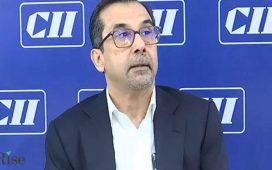Online home goods company Wayfair saw sales decline in its fiscal second quarter as its CEO called the current slowdown in the home goods category “unprecedented” — and likened it to the 2008 financial crisis.
“Our credit card data suggests that the category correction now mirrors the magnitude of the peak to trough decline the home furnishing space experienced during the great financial crisis,” Wayfair CEO Niraj Shah said in a news release. “Customers remain cautious in their spending on the home.”
The e-tailer fell short of Wall Street’s expectations on both the top and bottom lines. Shares closed more than 8% lower.
Here is how Wayfair did in its second fiscal quarter compared to what Wall Street was anticipating, based on a survey of analysts by LSEG:
- Earnings per share: 47 cents adjusted vs. 49 cents expected
- Revenue: $3.12 billion vs. $3.18 billion expected
The company reported a loss of $42 million, or 34 cents per share, in the three-month period that ended June 30. That is slightly better than the loss of $46 million, or 41 cents per share, that it posted during the same quarter a year earlier.
Sales dropped to $3.12 billion, down about 2% from $3.17 billion a year earlier. The slowdown in sales came even as average order values rose in the quarter from $313 to $307, and after the company opened its first large-format store.
For the current quarter, Wayfair expects revenue to be down in the low single digits, compared to estimates of 1.7% growth, according to LSEG.
For more than a year, home goods companies such as Wayfair have experienced sluggish demand for things including new couches and dining sets as the overall housing market turned stagnant against high interest rates. Consumers are buying fewer new homes, which means they have fewer reasons to buy new furniture. Plus, with stubborn inflation, they have been more choosy on where they are spending their discretionary income, and with options such as restaurants, new clothes and trips, home goods have not been a priority.
Wayfair has needed to entice customers with discounts to bring them in and does not expect to see a resurgence in the category until interest rates are cut and the housing market bounces back.
“We see declines that are similar to the declines that we saw in that 2008 to 2010 period and I think what that speaks to is that the category has been going through just a massive correction, a correction that we’ve previously only seen during a GDP recession,” Wayfair Chief Financial Officer Kate Gulliver told CNBC in an interview.
“Obviously we’re not technically in a GDP recession as a country right now, and so this is somewhat a unique thing to this category … we’ve seen that kind of recession-like correction in the category over the last few years.”
During a call with analysts, Shah called the slowdown in the home goods category “unprecedented” and said it is similar to what the space saw during the great financial crisis.
“Our credit card data suggests that the category was down by nearly 25% from the peak we saw in the fourth quarter of 2021,” said Shah. “Importantly, this calculation is on nominal dollars, adjusting for inflation suggests we’re now in the midst of a correction in excess of 35%, an unprecedented level of pullback in our sector.”
Reprieve could soon be on the way after Federal Reserve Chair Jerome Powell said interest rate cuts could come as soon as September as long as economic data continues on its current path.
“Given how deep we are into the cycle, it’s fair to expect a turnaround to come soon, and Wayfair is well positioned to benefit,” said Shah.
Wayfair, which has implemented a string of mass layoffs to get its cost structure in line with the current size of its business, has struggled to reach profitability, but the quarter was the best for free cash flow generation and adjusted EBITDA in three years, Shah said.
The company saw adjusted EBITDA of $163 million during the quarter, still below the $168 million that Wall Street had expected, according to StreetAccount.
“We are running the business with the goal of demonstrating substantial growth in profitability this year, even as the top line remains challenging. And that will be our mindset every year going forward as well,” said Shah.







